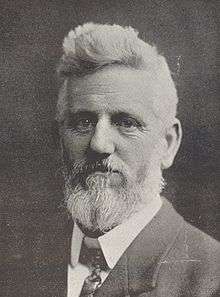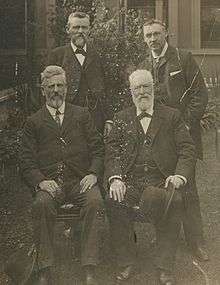Thomas Price (South Australian politician)
| Thomas Price | |
|---|---|
 | |
| 24th Premier of South Australia Elections: 1902, 1905, 1906 | |
|
In office 26 July 1905 – 5 June 1909 | |
| Monarch |
Edward VII George V |
| Governor |
Sir George Le Hunte Sir Day Bosanquet |
| Preceded by | Richard Butler |
| Succeeded by | Archibald Peake |
| 12th Leader of the Opposition (SA) | |
|
In office 1904–1905 | |
| Preceded by | John Darling |
| Succeeded by | Richard Butler |
| 3rd United Labor Party leader | |
|
In office 1899–1909 | |
| Preceded by | Lee Batchelor |
| Succeeded by | John Verran |
| Personal details | |
| Born |
January 19, 1852 Brymbo, Denbighshire, Wales, UK |
| Died |
May 31, 1909 (aged 57) Mount Lofty, South Australia, Australia |
| Political party | United Labor Party |


Thomas Price (19 January 1852 – 31 May 1909), frequently referred to as Tom Price, served as the South Australian United Labor Party's first Premier of South Australia. He formed a minority government at the 1905 election and was re-elected with increased representation at the 1906 double dissolution election serving until his death in 1909. It was the world's first stable Labor government. So successful, John Verran led Labor to form the state's first of many majority governments at the 1910 election.
Achievements of the government included free state secondary schools, the formation of wages boards and a minimum wage, establishing the Municipal Tramways Trust through nationalisation, the costly administration of the Northern Territory was surrendered to the Federal government, and reform (though limited) of the upper house. The government also returned to successive budget surpluses and reduced the accumulated public debt.
Early life
He was born in Brymbo, Denbighshire, Wales, and emigrated to Australia with his family in 1883. He was a stonecutter, teacher, lay preacher, businessman, stonemason, clerk-of-works, union secretary, union president and politician. He quickly became involved in trade union activity, and was elected to the South Australian House of Assembly for Sturt in April 1893,[1] becoming Labor leader in 1899. He contested the single statewide Division of South Australia at the 1901 federal election as the second of two Labor candidates behind Lee Batchelor. The seat elected seven members, Price finished eighth with a 38.2 percent vote.
World-first stable Labor government 1905−09
Price came to power at the 1905 state election in a minority government, the Price-Peake administration, after increasing his party's representation from five to 15 in the 42-member lower house, with a primary vote of 41.3 percent, an increase of 22.2 percent. With the support of eight liberals headed by Archibald Peake, Price forced conservative Premier Richard Butler to resign. Price retained the premiership at the 1906 double dissolution election with an additional five Labor seats in the House of Assembly, just two short of a parliamentary majority in their own right, with a primary vote of 44.8 percent, an increase of 3.5 percent. It was the world's first stable Labor government. So successful, John Verran led Labor to form the state's first of many majority governments at the 1910 election. On Price's death in 1909, Peake formed a minority government until 1910.
Price obtained the double dissolution on the issue of reform to the Legislative Council. The council continued to be intransigent to reform, however Price accepted the council's compromise proposal of a £17 householder franchise. Labor's left wing criticized him for this compromise.
He introduced many social reforms including free state secondary schools, the formation of wages boards and a minimum wage, establishing the Municipal Tramways Trust through nationalisation, the costly administration of the Northern Territory was surrendered to the Federal government, and reform (though limited) of the upper house. Numerous moral laws were also passed: suppression of brothels and gaming, control and care of drunkards, consolidation of legislation on the supply of alcohol and local option.[2] The government returned to successive budget surpluses and reduced the accumulated public debt.[3]
Legacy
Price died of phthisis (tuberculosis) and diabetes at Mount Lofty on 31 May 1909. He was given a state funeral and buried at Mitcham Cemetery.
An island of the Whidby Group off the south-west coast of Eyre Peninsula had been left unnamed after Matthew Flinders' early explorations. It was named Price Island by the Government of South Australia in Thomas Price's honour after his passing. A guiding light for mariners was also erected on the island.[4]
Family
Tom Price married Anne Elizabeth Lloyd (c. 1860 – 1 September 1950) in Liverpool on 14 April 1881. Their children included
- John Lloyd Price (14 February 1882 – 23 April 1941) MHA for Port Adelaide 1915–1925 and MHR.
- Walter Davies Price MC (24 March 1886 – 29 July 1944) distinguished soldier and public servant.
Other children were Edward Hugh Price (1884–1954), engineer with the Harbors Board, (Thomas) Arthur Price (1888–1942), a railways employee,[5] Annie Mary "Ann" Price (1890–1985), and Florence Gwendoline "Flo" Price (1894–1957) married Alfred Charles Clarke in 1920.
His widow was in 1915 one of four women appointed a Justice of the Peace,[6] the first in Australia.
Notes
- ↑ "Statistical Record of the Legislature 1836 to 2009" (PDF). Parliament of South Australia.
- ↑ Thomas Price: ADB
- ↑ Archibald Peake: ADB
- ↑ "Islands of the West Coast." The Register, South Australia (1925-09-02). Retrieved 2014-02-16.
- ↑ "A Rail Car Mishap". The Advertiser (Adelaide). South Australia. 25 October 1924. p. 13. Retrieved 27 August 2016 – via National Library of Australia.
- ↑ "Women Justices". The Barrier Miner. XXVIII, (8388). New South Wales, Australia. 7 July 1915. p. 4. Retrieved 27 August 2016 – via National Library of Australia.
References
- Steven Weeks, 'Price, Thomas (Tom) (1852 - 1909)', Australian Dictionary of Biography, Volume 11, MUP, 1988, pp287–289.
External links
| Political offices | ||
|---|---|---|
| Preceded by John Darling Jr. |
Leader of the Opposition of South Australia 1904–1905 |
Succeeded by Richard Butler |
| Preceded by Richard Butler |
Premier of South Australia 1905–1909 |
Succeeded by Archibald Peake |
| Preceded by Richard Foster |
Commissioner of Public Works 1905 – 1909 |
Succeeded by Laurence O'Loughlin |
| Parliament of South Australia | ||
| Preceded by William Stock |
Member for Sturt 1893–1902 Served alongside: John Jenkins |
District abolished |
| New district | Member for Torrens 1902–1910 Served alongside: John Jenkins |
Succeeded by Thomas Ryan |
| Party political offices | ||
| Preceded by Lee Batchelor |
Leader of the United Labor Party 1899–1909 |
Succeeded by John Verran |